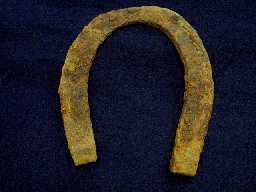

This essay is about historic
horseshoes and their development through time, from the first horseshoes made of
vegetable fibers to the modern iron horseshoe. The first type of horseshoe has
been dated to 1100 BC, it was made of vegetable fibers and fastened with lace.
The succeeding form was the so called hipposandal made of an ironplate instead
of vegetable fibers but still fastened with lace. There
has been much speculation over the years as to when and where the practice of
shoeing horses with nailed-on iron shoes was invented. Many scientists think it
was the Druids (i.e. around 500 BC) who invented the horseshoe nail, but there
is no firm evidence that they did. The nailed-on horseshoe spread across Europe
during the Crusades, a period of time between year 400 and 1300. Horseshoes
became thicker and heavier during the Middle Ages which lead to many problems
with lame horses. These thick iron-shoes affected the natural
hoof-mechanism, which is also described in this essay.
Introduktion
Jag har valt att skriva om historiska hovbeslag, men jag tar även upp hovmekanismen och dagens hovbeslag. Dessa ämnen är intimt sammanlänkade; utseendet på gamla hovbeslag jämförs alltid med dagens hovbeslag, och för att förstå varför vissa av de gamla hovbeslagen orsakade hältor måste man känna till hur hovmekanismen fungerar. Jag tar även upp lite nomenklatur såhär i början som kan vara bra att känna till innan man börjar läsa arbetet. Till slut kommer jag att diskutera fördelar och nackdelar med de gamla beslagen och lyckade konstruktioner som man idag börjat återgå till.
Detta är bara början av Sari Köttös vetenskapliga litteraturundersökning om Hästskon.
Ni som vill läsa mer kan mejla mej så skickar jag över filen som är ganska stor c:a 500 kb.